Top Crypto Trading Platforms in 2025







%201.svg)
%201.svg)
Big news: We’re cranking up the heat on AI-driven crypto analytics with the launch of the Token Metrics API and our official SDK (Software Development Kit). This isn’t just an upgrade – it's a quantum leap, giving traders, hedge funds, developers, and institutions direct access to cutting-edge market intelligence, trading signals, and predictive analytics.
Crypto markets move fast, and having real-time, AI-powered insights can be the difference between catching the next big trend or getting left behind. Until now, traders and quants have been wrestling with scattered data, delayed reporting, and a lack of truly predictive analytics. Not anymore.
The Token Metrics API delivers 32+ high-performance endpoints packed with powerful AI-driven insights right into your lap, including:
Getting started with the Token Metrics API is simple:
At Token Metrics, we believe data should be decentralized, predictive, and actionable.
The Token Metrics API & SDK bring next-gen AI-powered crypto intelligence to anyone looking to trade smarter, build better, and stay ahead of the curve. With our official SDK, developers can plug these insights into their own trading bots, dashboards, and research tools – no need to reinvent the wheel.
%201.svg)
%201.svg)
Understanding how to efficiently manage exposure in the dynamic world of cryptocurrency can seem daunting. Crypto indices provide a structured approach, helping investors and traders maintain diversified exposure without constant oversight. This article explores what crypto indices are, how they work, and why their rebalancing strategies are crucial in 2025.
A crypto index is a rules-based basket of digital assets that tracks a specific set of cryptocurrencies, such as the top-100 by market capitalization. These indices are designed to reflect broad market trends while reducing the complexity of individual asset management. They typically rebalance periodically to maintain consistent exposure, adapting to market fluctuations over time.
The core mechanism involves a few key processes:
Crypto indices offer several advantages:
Investors interested in accessing crypto indices can follow a straightforward process:
Crypto indices may suit different kinds of investors:
Understanding your trading style and risk appetite can help determine if a crypto index fits within your broader strategy.
Discover Crypto Gems with Token Metrics AI
A crypto index is a rules-based basket that tracks a defined set of assets (e.g., the top-100 by market cap), with a scheduled rebalance to keep exposure aligned. Token Metrics applies that idea and adds a regime switch to stablecoins.
Weekly. Constituents and weights update on schedule; if the market regime changes, the portfolio can switch between tokens and stablecoins outside that cadence.
A proprietary market signal. Bullish: hold the top-100 basket. Bearish: exit to stablecoins and wait for a re-entry signal.
At launch, funding options including wallet-funding supported by the embedded smart wallet and supported chains; USDC payouts are available when selling. Details are available during the buy/sell process.
No. The embedded wallet is self-custodial—you control your funds and keys.
Before confirming, you'll see estimated gas costs, platform fees, max slippage, and minimum expected value.
Visit the Token Metrics indices hub, open TM Global 100, and tap “Join Waitlist.” We will notify you once trading opens.
Self-custody: Embedded smart wallet with user-controlled keys. Transparency: Clear rules, holdings Treemap, and transactions logs. Fees: Shown before confirmation. Limitations: Signals can be wrong, no performance guarantees. Availability may vary by region and device.
Crypto is volatile and can lose value. Past performance does not predict future results. This article is for research and educational purposes only, not financial advice.
%201.svg)
%201.svg)
If you’ve ever wished for a crypto index that participates broadly in bull markets yet steps aside when risk turns south, this is it. Token Metrics Global 100 is a rules-based index that holds the top 100 crypto assets when our market signal is bullish—and moves fully to stablecoins when it isn’t. It rebalances weekly, shows transparent holdings and transaction logs, and can be purchased in one click with an embedded wallet. That’s disciplined exposure, minus the micromanagement. → Join the waitlist to be first to trade TM Global 100.
Two things define this cycle: speed and uncertainty. Narratives rotate in weeks, not months, and individual-coin risk can swamp portfolios. Indices let you own the market when conditions warrant, while a regime-switching approach aims to sidestep drawdowns by cutting risk to stablecoins. (A crypto index is a rules-based basket tracking a defined universe—here, a top-100 market-cap set—with scheduled rebalances.)
Regime switching: Bull: hold the top 100 by market cap. Bear: move fully to stablecoins, wait for a bullish re-entry signal.
Weekly rebalancing: Updates weights and constituents to reflect the current top-100 list.
Transparency: A Strategy modal explains rules; a Gauge shows the live market signal; Holdings appear in Treemap + Table; and every rebalance/transaction is logged.
What you’ll see on launch: Price tile • “100 tokens” • “rebalances weekly” • one-click Buy Index flow. → See the strategy and rules. (TM Global 100 strategy)
Time back: No more tracking 100 tickers or manual reweights. The weekly job runs for you.
Discipline on drawdowns: The stablecoin switch enforces risk management when the signal turns.
Less execution drag: One embedded wallet checkout vs. dozens of small trades that add slippage and fees.
See everything: Gauge → Treemap → Transactions Log—know what you hold, and what changed.
Own the market when it’s worth it: Capture broad upside in bullish regimes with top-100 breadth.
Open the Token Metrics Indices hub.
Tap TM Global 100 and select Join Waitlist.
(Optional) Connect wallet to preview the one-click Buy flow and funding options.
On launch, you’ll receive an email and in-app prompt.
Click Buy Index → review fees/slippage/holdings → confirm. Most users finish in ~90 seconds.
Track your position under My Indices with real-time P&L and a full transactions history. → Join the waitlist to be first to trade TM Global 100.
A rules-based basket that tracks a defined universe (here: top-100 market cap), with scheduled rebalances and clear inclusion criteria.
Weekly, with additional full-portfolio switches when the market regime changes.
A proprietary market signal. Bullish: hold top-100. Bearish: move fully to stablecoins until re-entry.
You’ll use the embedded wallet and supported on-chain assets; USDC is supported for selling. Funding options surface based on chain/wallet at checkout.
No. It’s an embedded, self-custodial smart wallet—you control funds.
At checkout, you’ll see estimated gas, platform fee, max slippage, and minimum expected value before confirming.
Visit the Indices hub, open TM Global 100, and tap Join Waitlist; we’ll notify you at launch.
Self-custody: Embedded smart wallet; you hold keys.
Operational clarity: Strategy modal, Holdings treemap/table, and Transactions log.
Fee & slippage preview: All shown before you confirm.
Regime logic limits: Signals can be wrong; switching can incur spreads and gas.
Region notes: Chain and asset support may vary by user wallet and jurisdiction.
Crypto is volatile and can lose value. Past performance is not indicative of future results. This article is for research/education, not financial advice.
If you want broad upside when it’s worth it and stablecoins when it’s not—with weekly rebalances, transparent logs, and a 90-second buy flow—Token Metrics Global 100 was built for you. Join the waitlist now and be first to trade at launch.
%201.svg)
%201.svg)
The cryptocurrency market has evolved from a niche digital experiment into a multi-trillion-dollar asset class. With thousands of tokens and coins available across hundreds of exchanges, the question isn't whether you should research before buying—it's how to conduct that research effectively. Smart investors know that thorough due diligence is the difference between identifying the next promising project and falling victim to a costly mistake.
Before diving into specific research methods, successful crypto investors start by understanding the fundamental difference between various digital assets. Bitcoin operates as digital gold and a store of value, while Ethereum functions as a programmable blockchain platform. Other tokens serve specific purposes within their ecosystems—governance rights, utility functions, or revenue-sharing mechanisms.
The first step in any research process involves reading the project's whitepaper. This technical document outlines the problem the project aims to solve, its proposed solution, tokenomics, and roadmap. While whitepapers can be dense, they reveal whether a project has substance or merely hype. Pay attention to whether the team clearly articulates a real-world problem and presents a viable solution.
A cryptocurrency project is only as strong as the team behind it. Investors scrutinize founder backgrounds, checking their LinkedIn profiles, previous projects, and industry reputation. Have they built successful companies before? Do they have relevant technical expertise? Anonymous teams aren't automatically red flags, but they require extra scrutiny and compelling reasons for their anonymity.
Development activity serves as a crucial health indicator for any blockchain project. GitHub repositories reveal whether developers are actively working on the project or if it's effectively abandoned. Regular commits, open issues being addressed, and community contributions all signal a vibrant, evolving project. Conversely, repositories with no activity for months suggest a project that may be dying or was never serious to begin with.
Understanding a token's economic model is essential for predicting its long-term value potential. Investors examine total supply, circulating supply, and emission schedules. Is the token inflationary or deflationary? How many tokens do the team and early investors hold, and when do those tokens unlock? Large unlock events can trigger significant price drops as insiders sell.
The token's utility within its ecosystem matters tremendously. Does holding the token provide governance rights, staking rewards, or access to platform features? Tokens without clear utility often struggle to maintain value over time. Smart researchers also investigate how value accrues to token holders—whether through buybacks, burning mechanisms, or revenue sharing.
Price action tells only part of the story, but market metrics provide valuable context. Trading volume indicates liquidity—can you buy or sell significant amounts without drastically moving the price? Market capitalization helps determine a token's relative size and potential growth runway. A small-cap project has more room to grow but carries higher risk.
On-chain metrics offer deeper insights into token health. Active addresses, transaction volume, and network usage reveal actual adoption versus speculation. High trading volume on exchanges with minimal on-chain activity might indicate wash trading or manipulation. Token distribution matters too—if a small number of wallets hold most of the supply, the token faces centralization risks and potential price manipulation.
Professional crypto investors increasingly rely on sophisticated analytics platforms that aggregate multiple data sources and provide actionable insights. Token Metrics has emerged as a leading crypto trading and analytics platform, offering comprehensive research tools that save investors countless hours of manual analysis.
Token Metrics combines artificial intelligence with expert analysis to provide ratings and predictions across thousands of cryptocurrencies. The platform evaluates projects across multiple dimensions—technology, team, market metrics, and risk factors—delivering clear scores that help investors quickly identify promising opportunities. Rather than manually tracking dozens of metrics across multiple websites, users access consolidated dashboards that present the information that matters most.
The platform's AI-driven approach analyzes historical patterns and current trends to generate price predictions and trading signals. For investors overwhelmed by the complexity of crypto research, Token Metrics serves as an invaluable decision-support system, translating raw data into understandable recommendations. The platform covers everything from established cryptocurrencies to emerging DeFi tokens and NFT projects, making it a one-stop solution for comprehensive market research.
Cryptocurrency projects thrive or die based on their communities. Active, engaged communities signal genuine interest and adoption, while astroturfed communities relying on bots and paid shillers raise red flags. Investors monitor project Discord servers, Telegram channels, and Twitter activity to gauge community health.
Social sentiment analysis has become increasingly sophisticated, with tools tracking mentions, sentiment polarity, and influencer engagement across platforms. Sudden spikes in social volume might indicate organic excitement about a partnership or product launch—or orchestrated pump-and-dump schemes. Experienced researchers distinguish between authentic enthusiasm and manufactured hype.
The regulatory landscape significantly impacts cryptocurrency projects. Researchers investigate whether projects have faced regulatory scrutiny, registered as securities, or implemented compliance measures. Geographic restrictions, potential legal challenges, and regulatory clarity all affect long-term viability.
Security audits from reputable firms like CertiK, Trail of Bits, or ConsenSys Diligence provide crucial assurance about smart contract safety. Unaudited contracts carry significant risk of exploits and bugs. Researchers also examine a project's history—has it been hacked before? How did the team respond to security incidents?
Experienced investors develop instincts for spotting problematic projects. Guaranteed returns and promises of unrealistic gains are immediate red flags. Legitimate projects acknowledge risk and market volatility rather than making impossible promises. Copied whitepapers, stolen team photos, or vague technical descriptions suggest scams.
Pressure tactics like "limited time offers" or artificial scarcity designed to force quick decisions without research are classic manipulation techniques. Projects with more focus on marketing than product development, especially those heavily promoted by influencers being paid to shill, warrant extreme skepticism.
Cryptocurrency research isn't a one-time activity but an ongoing process. Markets evolve rapidly, projects pivot, teams change, and new competitors emerge. Successful investors establish systems for monitoring their holdings and staying updated on developments. Setting up Google Alerts, following project social channels, and regularly reviewing analytics help maintain awareness of changing conditions.
Whether you're evaluating established cryptocurrencies or exploring emerging altcoins, thorough research remains your best defense against losses and your greatest tool for identifying opportunities. The time invested in understanding what you're buying pays dividends through better decision-making and improved portfolio performance in this dynamic, high-stakes market.

%201.svg)
%201.svg)
Altcoin bull runs are some of the most exciting periods in cryptocurrency, delivering life‑changing gains for prepared investors. These cycles often follow or coincide with Bitcoin rallies, as capital flows into smaller, high‑growth tokens in search of outsized returns.
In 2025, with AI‑powered platforms, institutional adoption, and innovative sectors like DeFi, AI tokens, and real‑world assets (RWAs) driving growth, the stage is set for a potentially historic altcoin bull run. This guide explains how to prepare, what to watch for, and how tools like Token Metrics can help you capitalize on this opportunity.
Understanding what drives these rallies is key to recognizing when one begins.

Preparation is everything. Here’s how to position yourself before the market takes off:
1. Build a Diversified Portfolio:
Combine large‑cap coins (Ethereum, Solana) with high‑potential small‑caps like Token Metrics AI (TMAI) or narrative‑driven DeFi tokens.
2. Use AI‑Powered Analytics:
Token Metrics leverages over 80 data points per token—including technicals, fundamentals, and sentiment—to help you spot early movers before the crowd.
3. Set Entry and Exit Plans:
Define profit targets and stop‑loss levels before entering trades to avoid emotional decisions during volatility.
4. Stay Liquid:
Keep a portion of your portfolio in stablecoins to seize opportunities during sharp pullbacks.

The next altcoin season will likely be driven by powerful narratives:
With great opportunity comes great risk. Here’s how to protect your gains:
Token Metrics is an essential tool for navigating altcoin bull markets, offering:
This data‑driven approach helps investors stay ahead of the crowd and avoid emotional decision‑making during fast‑moving markets.
As crypto matures, AI‑enhanced analytics, regulatory clarity, and wider institutional adoption are likely to make future altcoin seasons more sustainable and inclusive.
In 2025, the winners will be those who combine smart preparation, narrative awareness, and AI‑powered tools like Token Metrics to maximize returns.
The 2025 altcoins bull run could be one of the most lucrative in crypto history, but success requires preparation, strategy, and discipline.
By diversifying across high‑potential narratives, using AI‑driven insights from Token Metrics, and following a clear plan, you can profit from explosive growth while managing risk effectively.
In altcoin bull runs, timing, data, and psychology are everything—get them right, and the opportunities are limitless.
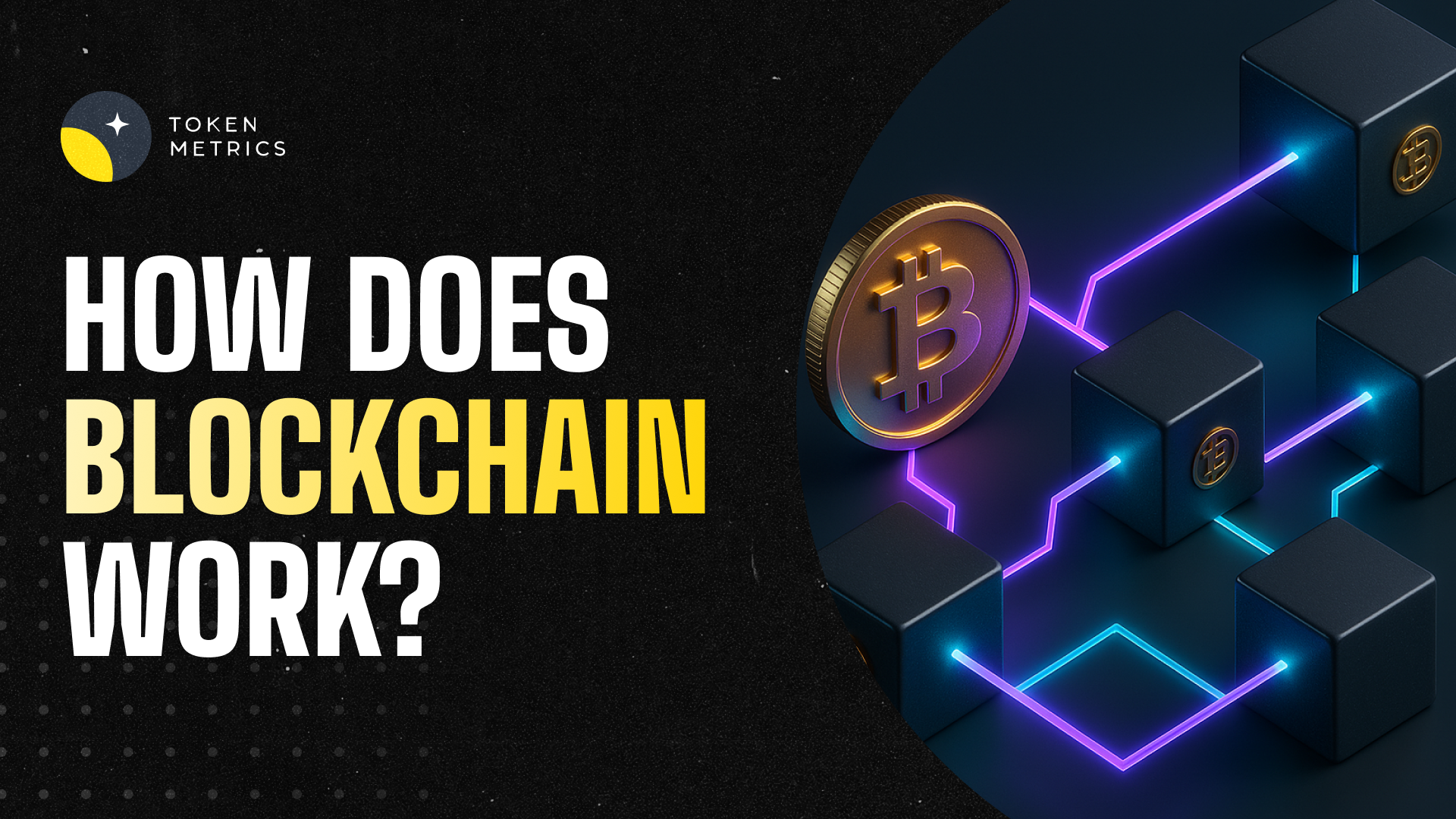
%201.svg)
%201.svg)
Blockchain is the foundation of modern cryptocurrency and one of the most transformative technologies of the digital age. Initially created to support Bitcoin, blockchain has expanded into countless use cases, from decentralized finance (DeFi) to supply chain tracking, real-world asset tokenization, and artificial intelligence (AI) integration.
In 2025, understanding how blockchain works is essential—not just for crypto investors but for anyone navigating the evolving digital economy. This article explains the structure, components, and applications of blockchain in simple terms and explores how platforms like Token Metrics use blockchain data to help investors make smarter decisions.
At its core, blockchain is a distributed digital ledger that records transactions across a network of computers. Unlike traditional databases controlled by a single entity, blockchain operates on a decentralized network, making it secure, transparent, and tamper-resistant.
Each entry in this ledger is grouped into a “block,” and these blocks are linked (or chained) together in chronological order—hence the name blockchain.
Consensus mechanisms are protocols that ensure all nodes agree on the state of the blockchain.
In 2025, hybrid models combining public and private features are increasingly popular for balancing transparency with privacy.
Platforms like Token Metrics take blockchain a step further by:
By combining blockchain transparency with AI-powered analytics, Token Metrics provides a comprehensive view of crypto investments.
In 2025, blockchain continues to evolve beyond cryptocurrencies. With advances in scalability solutions, real-world asset tokenization, and AI integration, blockchain is shaping the next generation of financial systems, digital identity solutions, and decentralized applications.
As enterprises, governments, and investors adopt blockchain, its role in the digital economy will only grow.
Blockchain is more than a buzzword—it’s a transformative technology driving innovation across industries. By understanding how blockchain works—its structure, consensus mechanisms, and applications—you can better navigate the crypto market and the broader digital landscape.
Platforms like Token Metrics make blockchain analysis accessible and actionable, offering AI-driven insights to help investors capitalize on this rapidly expanding technology. In 2025, mastering blockchain fundamentals isn’t just helpful—it’s essential for participating in the future of finance and digital ownership.

%201.svg)
%201.svg)
In the fast-paced world of cryptocurrency investing, market capitalization, often called market cap, is one of the most essential metrics for evaluating projects. It helps investors quickly gauge a coin’s size, value, and growth potential, making it a cornerstone for portfolio allocation and risk management.
Whether you’re a beginner trying to understand which cryptocurrencies to buy or an experienced trader managing a complex portfolio, understanding coin market cap is critical. In this guide, we’ll break down what market cap is, how to use it effectively, its limitations, and how platforms like Token Metrics can enhance your analysis with advanced data insights.
Market capitalization refers to the total value of a cryptocurrency in circulation. It’s calculated using a simple formula:
Market Cap=Current Price×Circulating Supply\text{Market Cap} = \text{Current Price} \times \text{Circulating Supply}

For example, if a cryptocurrency is priced at $20 and has 50 million coins in circulation, its market cap would be $1 billion. This figure provides a snapshot of the project’s relative size and its standing in the broader crypto market.
Market cap is an invaluable metric for quickly comparing projects, identifying potential opportunities, and understanding the level of risk associated with an investment.
Market cap plays a crucial role in crypto investing for several reasons:
Cryptocurrencies are typically categorized by their market cap:
While market cap is only one part of the puzzle, it’s a powerful tool when used correctly. Here’s how to incorporate it into your strategy:
Although market cap is a useful metric, it has its shortcomings:
This is why market cap analysis should always be combined with other key metrics and qualitative research, which is where Token Metrics becomes invaluable.
While traditional market cap data offers a snapshot, Token Metrics goes deeper by analyzing:
This AI-powered approach allows investors to identify truly undervalued projects that might be overlooked by simply glancing at market cap.
Market cap is most powerful when used alongside:
Combining these insights with market cap offers a more complete view of a project’s health and potential.
Coin market cap remains one of the most fundamental metrics for analyzing cryptocurrencies. It provides a clear picture of project size and helps investors allocate capital effectively.
However, market cap alone isn’t enough. To make smarter, data-driven decisions, investors should combine market cap insights with on-chain data, technical analysis, and AI-driven insights from Token Metrics.
In 2025, using market cap alongside advanced analytics can help you identify undervalued opportunities, manage risk effectively, and build a balanced, growth-oriented crypto portfolio.

%201.svg)
%201.svg)
Over the past decade, cryptocurrency has moved from an experimental technology to a mainstream investment asset. What started with Bitcoin as a digital alternative to cash has evolved into a multi-trillion-dollar ecosystem encompassing altcoins, decentralized finance (DeFi), AI-powered tokens, and NFTs.
In 2025, crypto is no longer a fringe idea—it’s an essential consideration for forward-thinking investors. Whether you’re seeking growth, diversification, or a hedge against inflation, crypto offers multiple paths to wealth creation. This article explores why crypto is a valuable investment, how to approach it strategically, and the role of Token Metrics in making data-driven decisions.

Mitigate these risks by conducting thorough research and using Token Metrics AI to assess tokens based on fundamentals, on-chain activity, and market sentiment.

Token Metrics is a game-changing platform for crypto investors. It provides AI-powered coin ratings, trend analysis, and portfolio management tools. With over 80 data points per token, it helps investors identify undervalued coins and time market entries effectively.
In 2025, crypto remains a compelling investment option for those willing to manage its risks. By leveraging Token Metrics for data-driven insights and combining long-term strategies with diversified holdings, investors can position themselves for strong returns in the evolving digital asset landscape.

%201.svg)
%201.svg)
As the cryptocurrency market evolves, altcoins—cryptocurrencies other than Bitcoin—are becoming increasingly central to the digital asset ecosystem. Investing in altcoins can provide opportunities for higher returns, portfolio diversification, and exposure to innovative blockchain technologies.
Unlike Bitcoin, which is primarily seen as digital gold, altcoins serve varied purposes, such as powering decentralized applications, enabling smart contracts, or facilitating cross-border payments. In 2025, altcoin investments are gaining momentum among both retail and institutional investors, offering unique opportunities in emerging sectors like artificial intelligence (AI), decentralized finance (DeFi), and real-world asset tokenization.
Altcoins are cryptocurrencies designed as alternatives to Bitcoin. They differ in technology, use case, and governance structure, making them essential to a diversified crypto portfolio.
Categories of Altcoins include:

By investing in a mix of these categories, investors gain exposure to multiple narratives driving the crypto market forward.
Investing in altcoins involves buying and holding tokens, trading them for profit, or staking them for passive income. The process starts with choosing a reliable cryptocurrency exchange, creating a secure wallet, and identifying which tokens fit your portfolio strategy.
Key steps for altcoin investment:
1. Higher Growth Potential:
Altcoins often outperform Bitcoin during bull markets. Projects in sectors like AI, DeFi, and NFTs can yield outsized returns when demand surges.
2. Diversification:
Altcoins provide exposure to multiple sectors, reducing reliance on Bitcoin’s price movements.
3. Innovation:
Many altcoins drive technological breakthroughs in blockchain scalability, privacy, and decentralized governance.
4. Passive Income Opportunities:
Through staking and yield farming, investors can earn consistent returns on altcoin holdings.
While altcoins can deliver impressive gains, they also carry significant risks:
Mitigating these risks involves thorough research, diversification, and using analytics tools to assess project viability.
Bitcoin is considered a store of value, while altcoins offer greater utility and innovation. Here’s how they compare:
A balanced strategy typically includes Bitcoin for security and altcoins for growth.
Investing securely in altcoins requires:
Altcoins often face different regulatory classifications than Bitcoin, especially tokens associated with securities or DeFi platforms. In 2025, governments are increasingly requiring Know Your Customer (KYC) and Anti-Money Laundering (AML) compliance for crypto platforms.
Investors should ensure they use regulated exchanges and stay informed about local laws affecting altcoin trading.
When selecting altcoins to invest in:
In 2025, altcoins are poised to play a transformative role in finance, AI integration, and global blockchain adoption. Tokens tied to AI analytics, DeFi platforms, and real-world assets are expected to lead the next wave of growth.
Altcoin investment is more than a high-risk gamble—it’s a way to participate in the future of digital finance. By understanding altcoins’ categories, benefits, risks, and strategies, investors can make informed decisions and unlock substantial growth opportunities.
With the right tools, like AI-powered analytics from Token Metrics, and a disciplined approach, altcoins can become a cornerstone of a well-balanced crypto portfolio in 2025 and beyond.
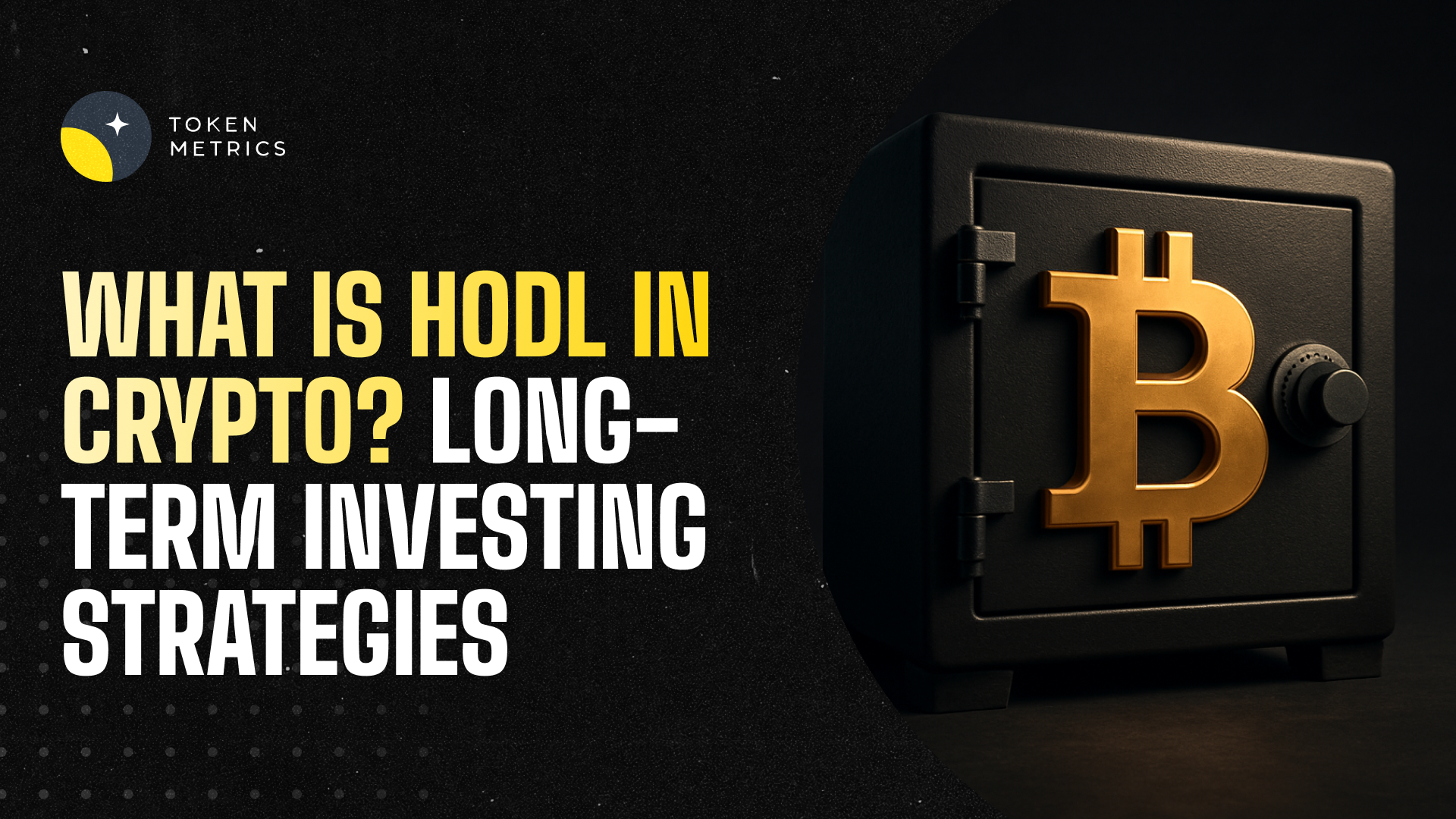
%201.svg)
%201.svg)
If you’ve spent any time in cryptocurrency communities, you’ve likely seen the term HODL. Originally a misspelling of “hold” on an online Bitcoin forum in 2013, HODL has become much more than a typo—it’s now a core investment philosophy for crypto enthusiasts worldwide.
In 2025, HODLing remains one of the most effective long-term strategies for building wealth in cryptocurrency. By holding onto fundamentally strong assets through market volatility, investors can capture long-term gains while avoiding emotional, short-term trading mistakes. This article explores what HODLing means, why it works, the best assets to HODL, and how platforms like Token Metrics can help optimize your strategy.
HODL means buying and holding cryptocurrency for an extended period, regardless of short-term price fluctuations. Unlike traders who attempt to time the market, HODLers adopt a long-term mindset, trusting that the value of quality assets will increase over time.
This strategy is rooted in the belief that blockchain technology and digital assets are here to stay, and that short-term market noise shouldn’t derail long-term conviction.
Crypto markets are notoriously volatile, with sudden price swings that can lead to emotional decision-making. HODLing combats this by:
By committing to HODLing, investors can overcome emotional biases and stay focused on their long-term goals.
While any coin can be HODLed, the best long-term candidates are projects with strong fundamentals, proven track records, and growing ecosystems:

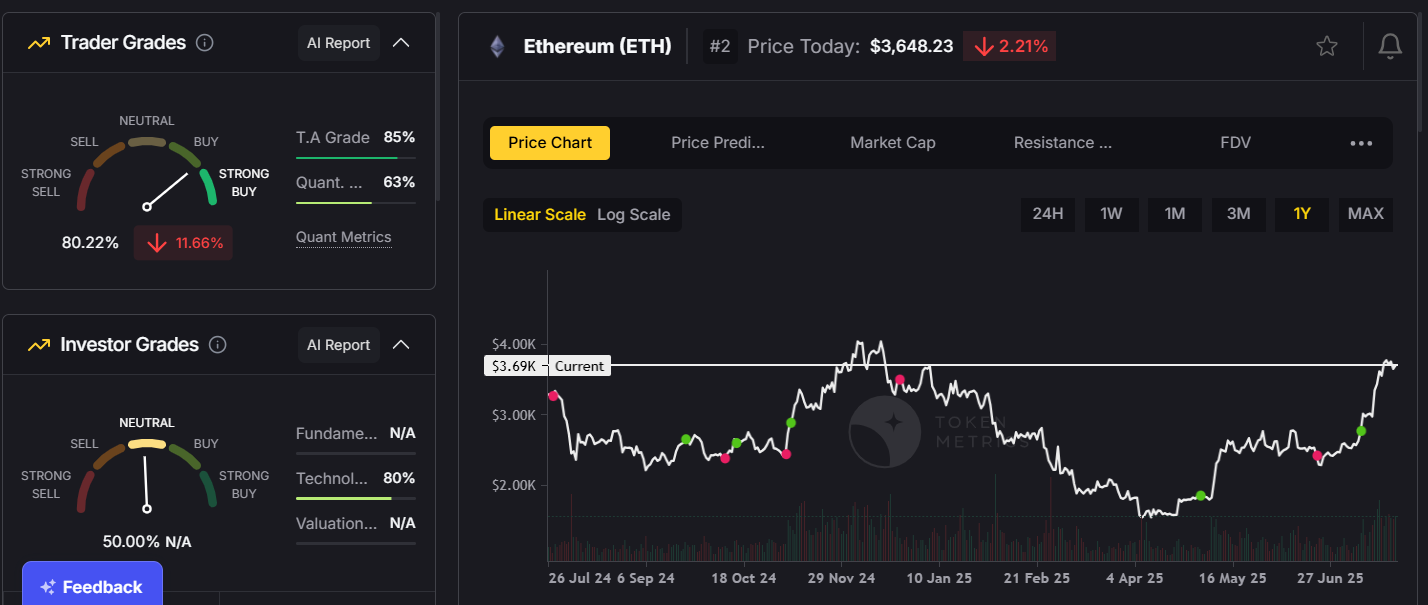
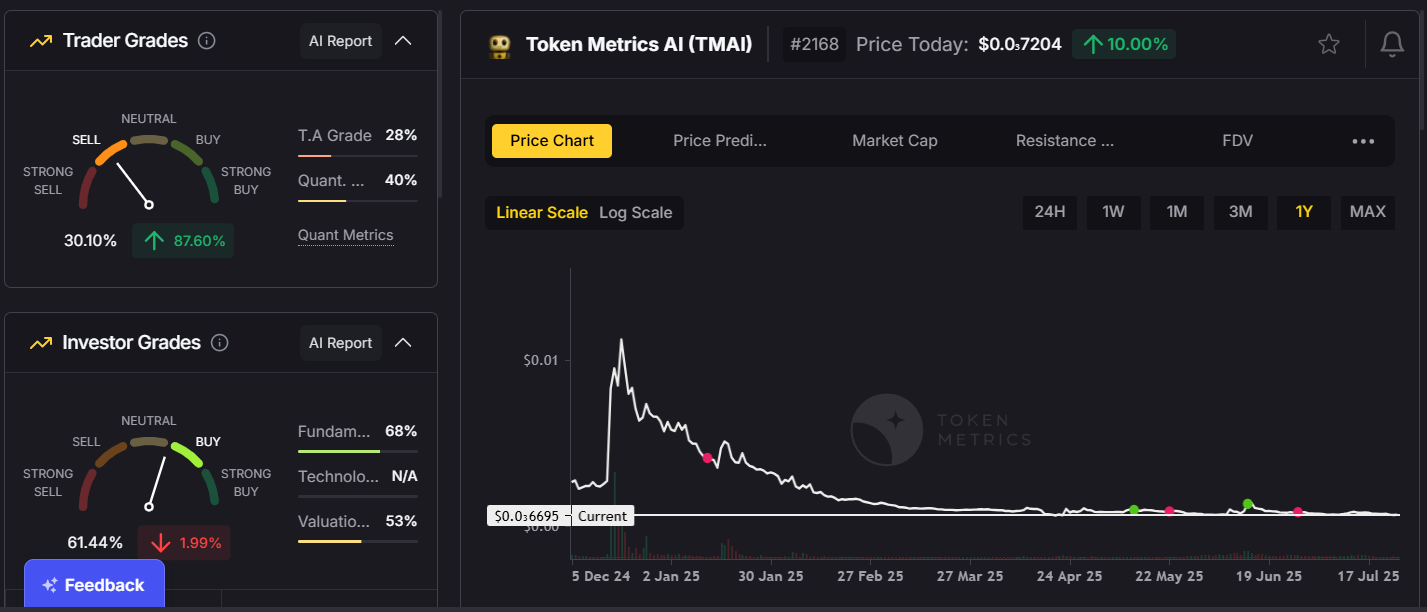
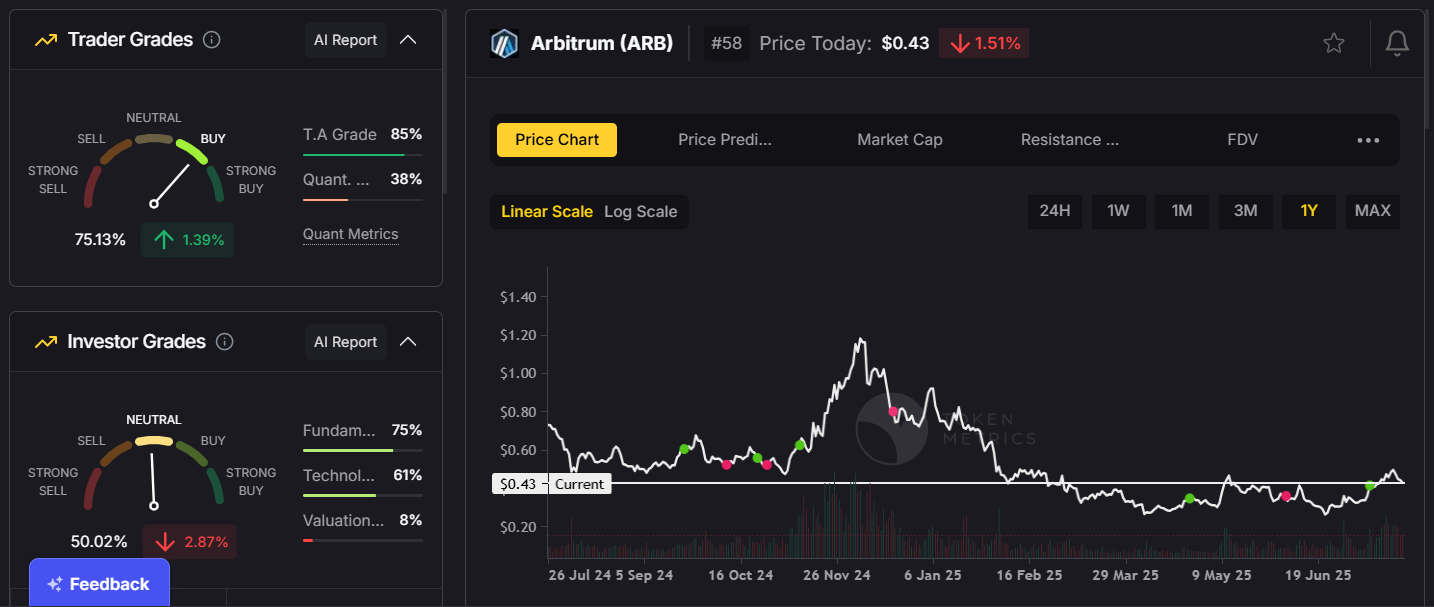
These coins offer long-term growth potential, making them excellent candidates for a HODL strategy.
While active trading can generate quick profits, it also comes with higher risks and costs. Here’s how HODLing compares:
Platforms like Token Metrics can complement both approaches by providing trading signals and long-term portfolio analytics, helping you decide when (and if) you should adjust your positions.
While HODLing is effective, it’s not without challenges:
To mitigate these risks, rely on data-driven tools like Token Metrics to ensure you’re holding the right mix of assets.
Token Metrics is a powerful platform for long-term crypto investors, providing:
By leveraging AI analytics, Token Metrics makes HODLing smarter, ensuring you’re invested in assets with strong fundamentals and growth potential.
HODLing isn’t just a meme—it’s a time-tested strategy for building wealth in crypto. By holding onto fundamentally strong assets, you can capture long-term growth while avoiding the emotional traps of active trading.
In 2025, pairing HODLing with AI-powered insights from Token Metrics gives you an edge—helping you select the right assets, manage risk, and stay committed to your investment plan. Whether you’re a beginner or a seasoned investor, HODLing remains one of the simplest and most effective ways to build wealth in the dynamic world of cryptocurrency.
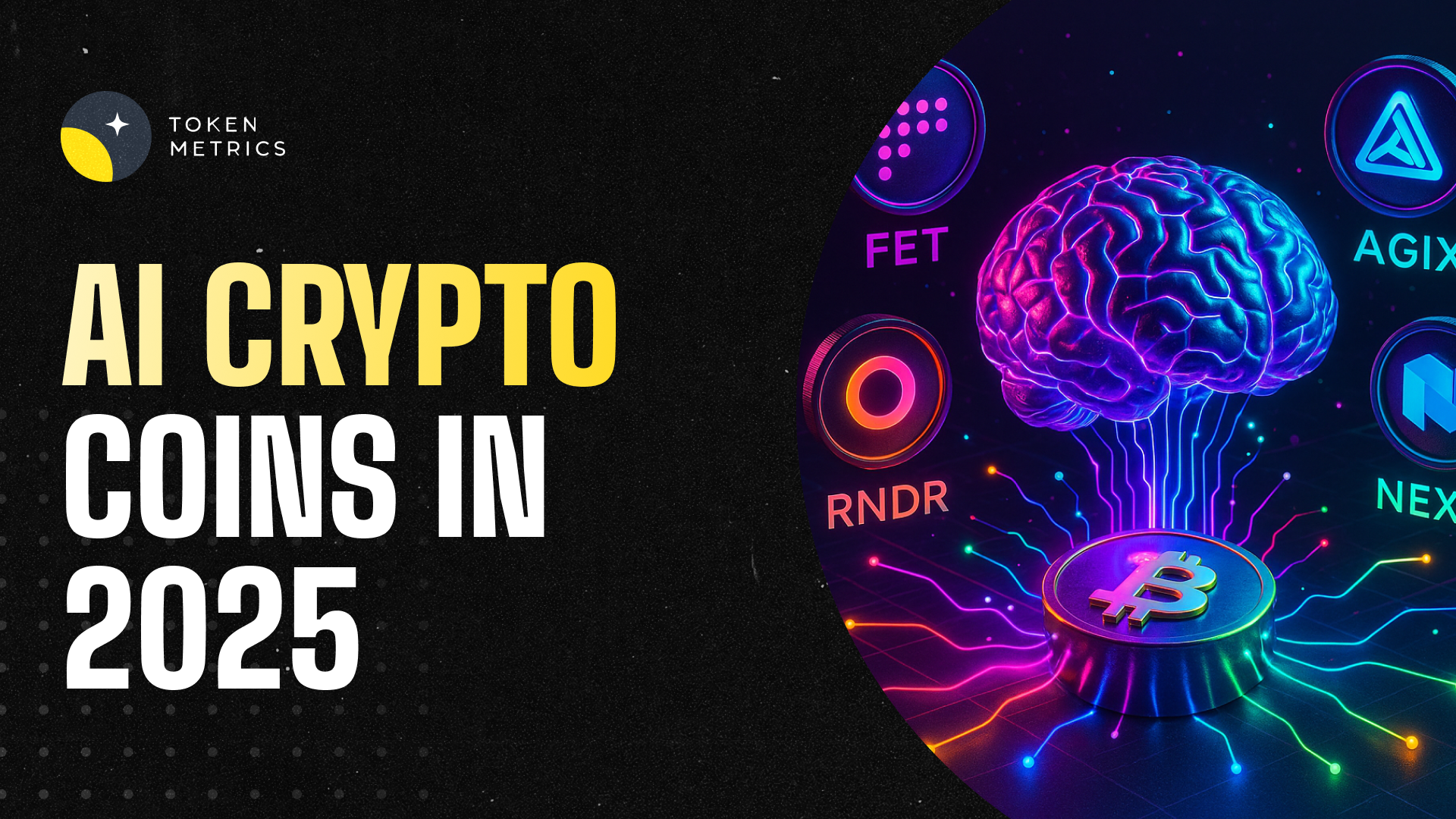
%201.svg)
%201.svg)
Artificial intelligence (AI) has become one of the most transformative technologies of our time, reshaping industries from healthcare to finance. In the cryptocurrency space, AI crypto coins are merging blockchain with artificial intelligence, creating powerful ecosystems for data analytics, automated decision-making, decentralized AI marketplaces, and predictive trading.
In 2025, AI-powered tokens are one of the most promising sectors in crypto, attracting retail investors, institutional players, and developers seeking the next wave of technological breakthroughs. This article explores what AI crypto coins are, how they work, their benefits, key risks, and the role of Token Metrics in analyzing and investing in them.
AI crypto coins are digital tokens that fuel blockchain platforms integrated with artificial intelligence technologies. These coins serve multiple purposes, including:
By combining the transparency of blockchain with the intelligence of AI, these projects are creating self-sustaining ecosystems where users can buy, sell, and deploy AI services securely.
The AI crypto sector is diverse, with projects addressing various use cases. Here are some of the leading tokens:
One of the most innovative AI-driven analytics platforms in crypto. TMAI leverages over 80 data points per token, offering AI-generated ratings, trend analysis, and portfolio insights to help traders and investors make data-driven decisions.
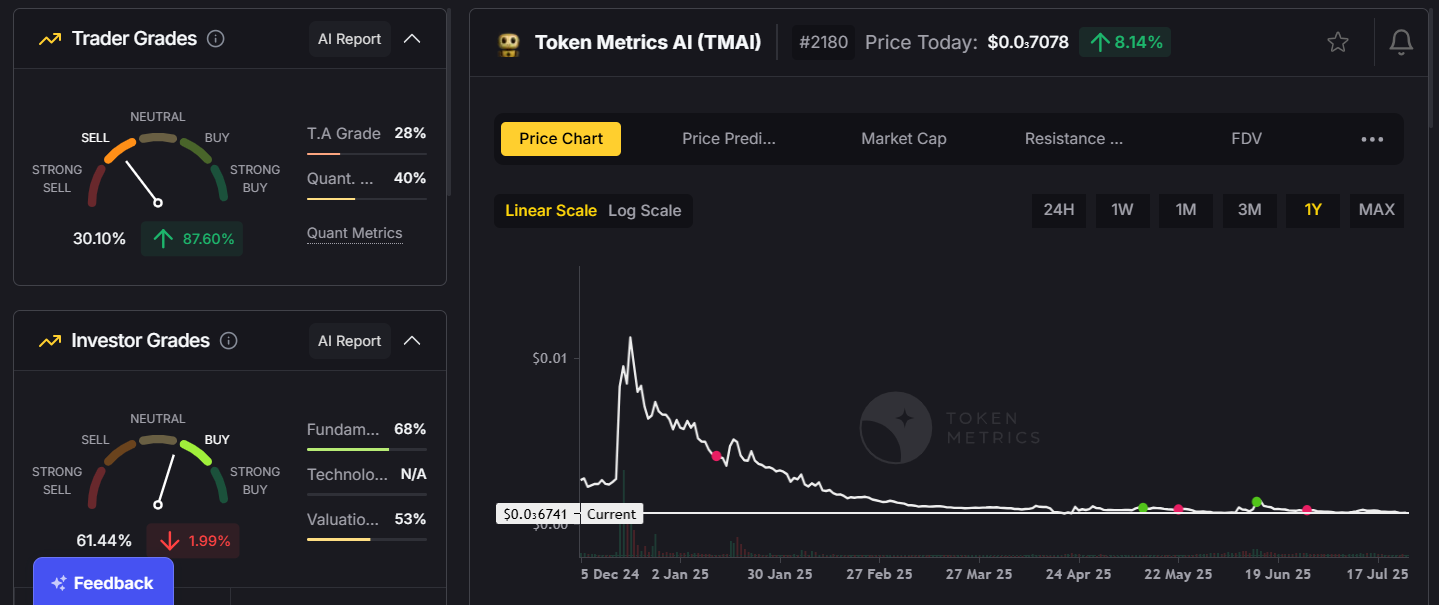
2. $KAITO Token Utility:
3. Cookie.fun ($COOKIE): Gamified Trading Meets A
Cookie.fun is a Gen-Z-targeted platform that fuses AI-powered trading insights with gamified investing experiences.
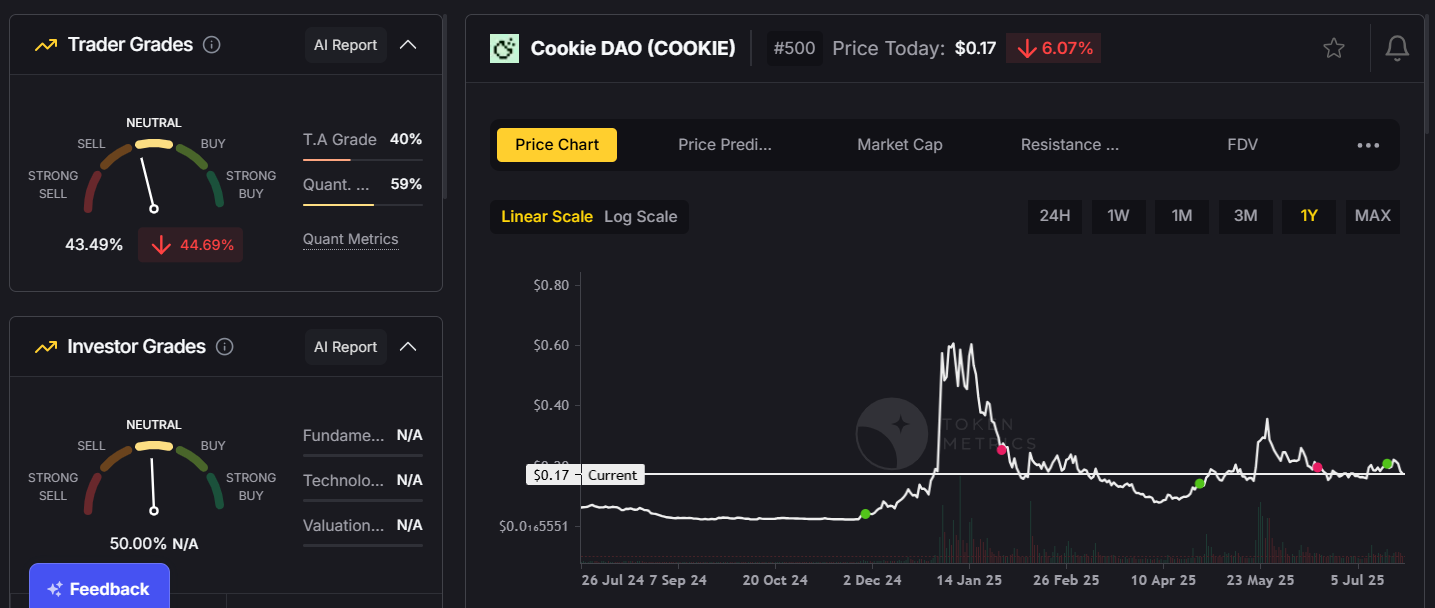
4. Arkham Intelligence (ARKM):
An AI-powered blockchain intelligence platform that analyzes on-chain data for compliance, forensics, and research.

These tokens are part of a fast-growing ecosystem of AI-focused projects poised to disrupt industries ranging from financial trading to decentralized computing.
AI crypto coins work by integrating machine learning and blockchain to create scalable, secure, and transparent AI ecosystems. Key mechanisms include:
This synergy between AI and blockchain creates systems that learn, adapt, and evolve over time, making them highly valuable in the crypto economy.
1. Exposure to Two Revolutionary Technologies:
Investing in AI tokens means gaining exposure to both the blockchain and AI sectors, which are projected to experience massive growth over the next decade.
2. High Growth Potential:
AI crypto coins often see rapid adoption due to their real-world applications and strong narratives.
3. Diversification:
AI tokens provide a unique asset class within the crypto market, helping diversify a portfolio beyond standard altcoins.
4. Early Access to Innovation:
Investors can be part of groundbreaking projects building the infrastructure for decentralized AI networks.
Like all crypto assets, AI coins carry risks:
Using data-driven platforms like Token Metrics can help mitigate these risks by offering detailed project analysis and ratings.
1. Long-Term Holding (HODL):
Invest in leading AI tokens like TMAI, FET, and AGIX for long-term exposure to this emerging sector.
2. Narrative Investing:
Capitalize on market narratives by entering early when AI projects gain traction or announce major updates.
3. Portfolio Diversification:
Balance AI tokens with large-cap cryptocurrencies like Bitcoin and Ethereum to manage overall portfolio risk.
4. Active Monitoring with Token Metrics:
Use Token Metrics to receive real-time AI-generated ratings, alerts, and trend analyses for AI tokens, helping you optimize entry and exit points.
Token Metrics is uniquely positioned at the intersection of AI and crypto. It provides:
For investors seeking to navigate the fast-changing AI crypto sector, Token Metrics delivers data-driven confidence in decision-making.
AI crypto coins are expected to play a transformative role in 2025 and beyond, powering innovations in:
As AI becomes more integrated with blockchain, these coins will likely lead the next technological and financial revolution.
AI crypto coins represent one of the most exciting frontiers in cryptocurrency. By merging the power of blockchain with the intelligence of AI, these tokens are reshaping how we interact with data, trade, and build decentralized systems.
For investors, platforms like Token Metrics provide the insights needed to navigate this dynamic sector—identifying promising projects, managing risk, and seizing opportunities before the market catches up.
In 2025, adding AI tokens to your portfolio isn’t just an investment—it’s a way to participate in the future of intelligent, decentralized finance.
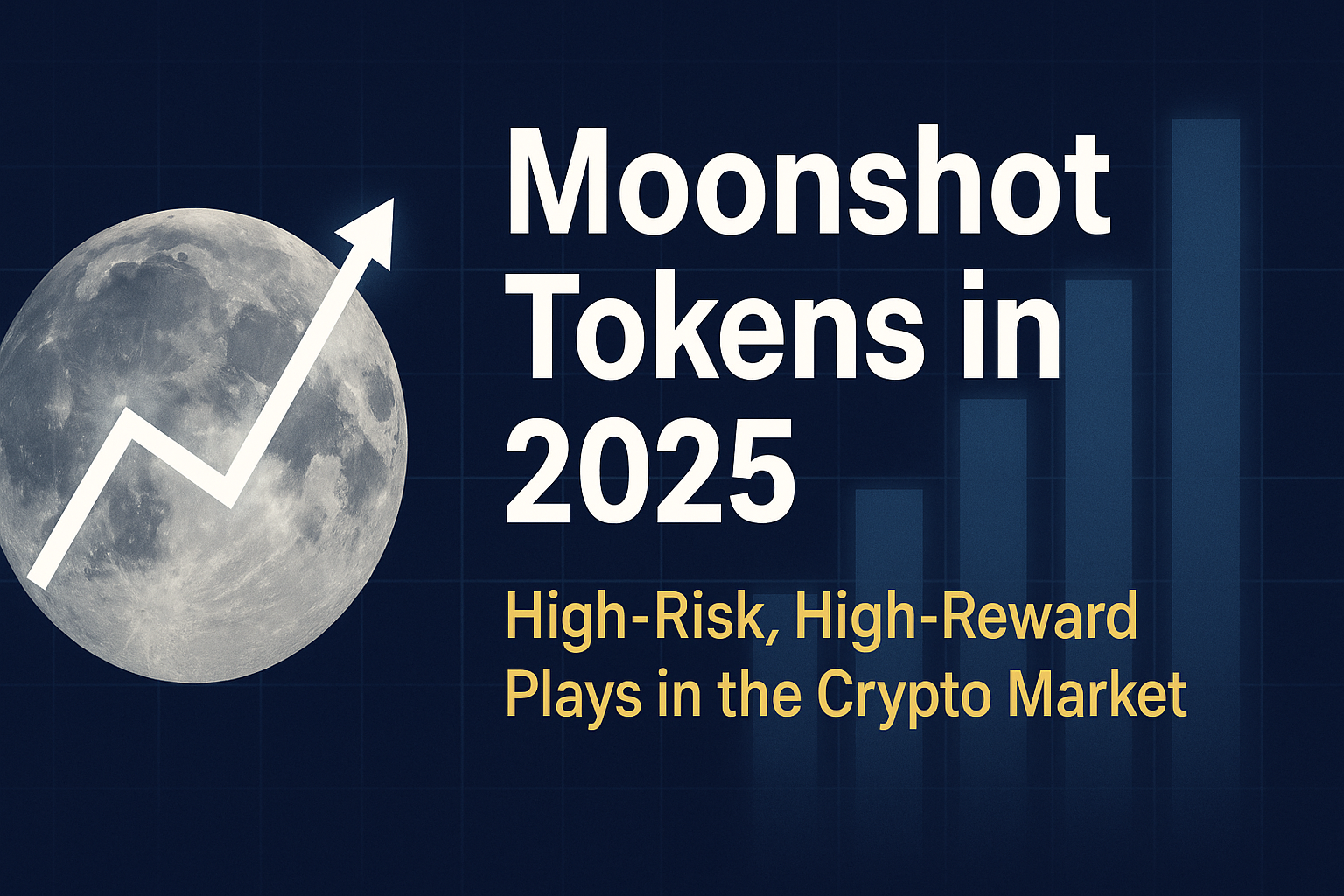
%201.svg)
%201.svg)
The crypto market has always been fertile ground for high-risk, high-reward opportunities. While blue-chip assets like Bitcoin and Ethereum dominate headlines, the real thrill — and sometimes the highest returns — often comes from what the industry calls “moonshots.”
These are small-cap tokens, often under $50 million in market cap, with explosive potential and equally high volatility. In 2025, moonshots remain a core part of speculative trading strategies. But what exactly are they? How do you find them? And most importantly, how can you manage the outsized risks they carry?
Let’s dive into the world of moonshots, drawing insights from recent market trends and real-world data.
Moonshot tokens are early-stage, low-cap cryptocurrencies that carry massive upside potential. They often represent experimental ideas or emerging narratives — think AI integration, meme culture, or social tokens — that haven’t yet been fully recognized by the broader market.
Because they trade at relatively low valuations, even small inflows of capital can cause outsized price swings. It’s not uncommon for a moonshot to deliver 10x or even 50x gains within a short time. But the flip side is brutal: these same tokens can plummet to zero just as quickly.
Key characteristics of moonshots:
The current market environment — with crypto market capitalization hovering around $4 trillion — has created room for risk-taking. Investors who missed early gains on Bitcoin or Ethereum are now searching for the next big thing, leading to renewed interest in small-cap tokens.
Emerging narratives also fuel the fire:
These narratives often spill over into the moonshot arena, as smaller projects attempt to replicate the success of these headline-grabbing platforms.
Identifying moonshots is part research, part intuition, and part risk tolerance. Here’s what to look for:
The most successful moonshots ride on current narratives. In this cycle, AI agents, decentralized social platforms, and community-owned DeFi projects are leading themes. Projects in these categories often experience rapid hype-driven adoption.
Tools like Dune Analytics and on-chain scanners can reveal whale accumulation, new liquidity pools, or spikes in active addresses — all early indicators of growing interest.
Evaluate supply schedules:
While many moonshots are grassroots projects, strong teams or backing from reputable funds (e.g., Polychain, Binance Labs) can boost credibility.
1. Vine (Meme Token):
A meme coin leveraging the Vine brand, this token has gained traction despite limited documentation. Its appeal lies largely in nostalgia and speculative hype.
2. Moby AI: What started as an AI-driven whale-tracking agent has evolved into Mobi Screener, a Dexscreener competitor with integrated social features. The token model ties platform usage to token value — a promising experiment in utility-driven moonshots.
3. Graphite Protocol:
Developers behind Bonk Fun (a leading meme token platform), Graphite has created a buyback and burn model linked to Bonk’s success, aligning token value directly with ecosystem growth.
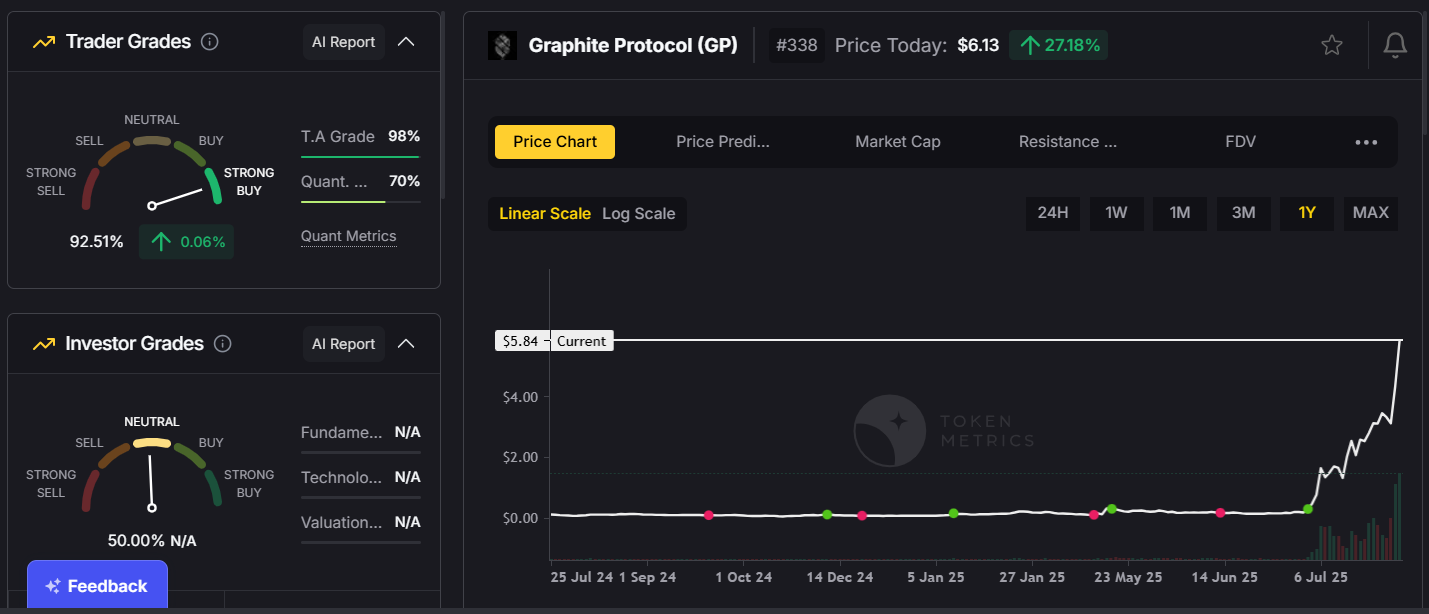
4. CookieDAO:
Initially positioned as an AI agent platform, CookieDAO is now expanding into proof-of-belief systems, adding new utilities and campaign features for Web3 projects.
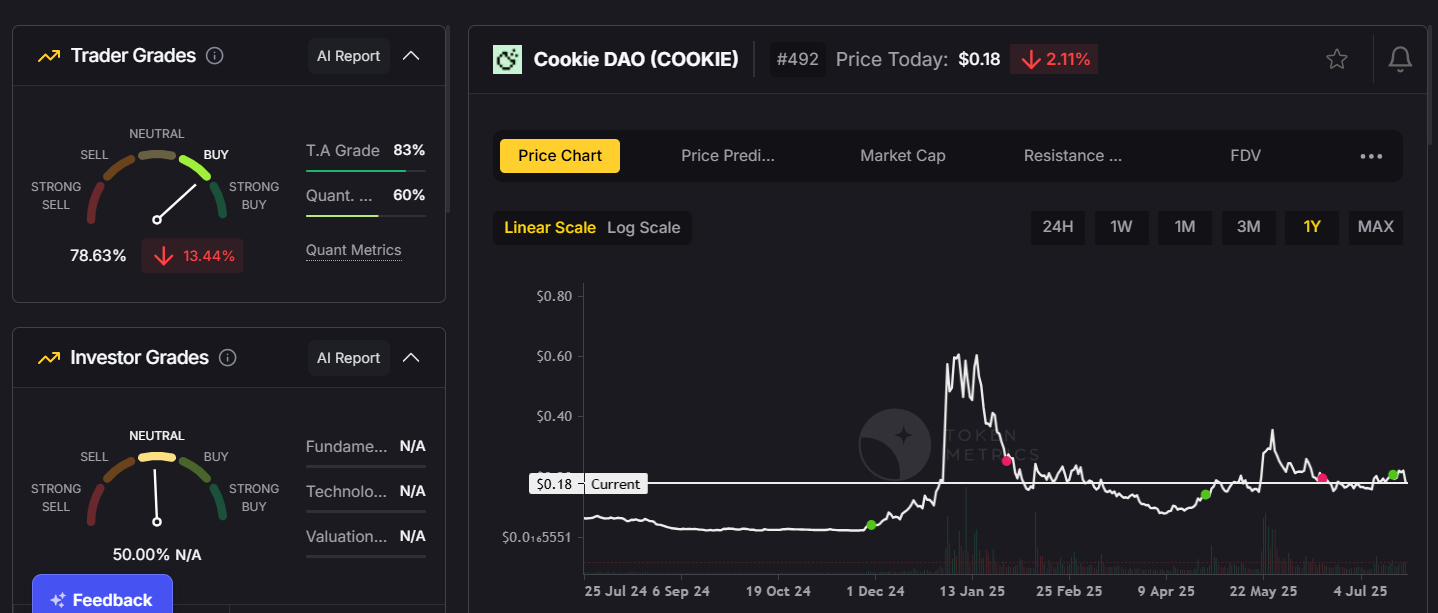
Moonshots are inherently speculative. Common pitfalls include:
A recent example is SpaceMesh, once hyped as a “next Bitcoin.” Despite strong tech, internal disputes and poor execution led to a near-total collapse — a stark reminder that good code doesn’t always equal good investment.
If you’re trading moonshots, risk management is everything.
1. Position Sizing:
Never allocate more than 1% of your portfolio to any single moonshot. Spreading capital across multiple small positions reduces the impact of one token collapsing.
2. Diversification:
Balance moonshots with higher-cap tokens to stabilize overall portfolio performance.
3. Predefined Exits:
Set clear take-profit and stop-loss levels before entering a trade. Emotional decisions often lead to losses.
4. Time Your Entries:
Consider entering after initial hype cools but before major announcements or roadmap milestones.
While moonshots can be risky, they remain an integral part of crypto’s DNA. For many traders, they serve as lottery tickets in a market where early discovery can lead to life-changing gains.
In 2025, moonshots are evolving. They’re no longer just meme-driven gambles. Increasingly, they represent experimental innovation — blending DeFi models, AI integrations, and community governance in ways that push the boundaries of blockchain technology.
Moonshots are not for the faint-hearted. They require research, timing, and above all, discipline. In 2025, with themes like AI-driven platforms, decentralized social networks, and community-focused DeFi reshaping the market, the next breakout token could be hiding in plain sight.
Whether you’re a seasoned trader or a curious newcomer, understanding the dynamics of moonshots — and respecting their risks — is essential for navigating this volatile but potentially rewarding segment of crypto.

%201.svg)
%201.svg)
The cryptocurrency market continues to show resilience, with total market capitalization maintaining a strong foothold near $4 trillion. While Bitcoin remains the cornerstone of this cycle, the spotlight is shifting toward altcoins — especially those at the forefront of decentralized finance (DeFi) and artificial intelligence (AI) integration.
In this blog, we’ll explore the top narratives shaping today’s market, focusing on DeFi protocols like Blackhole DEX and PancakeSwap, alongside emerging AI projects such as Sahara AI and Moby AI.
DeFi has staged an impressive comeback in 2025. After a period of stagnation, several protocols have redefined their models to prioritize community engagement and sustainable growth.
Black Hole DEX:
Launched on Avalanche, Blackhole DEX has quickly become the network’s largest decentralized exchange, overtaking Trader Joe. The platform uses a community-first approach: no team allocation, weekly token emissions to liquidity providers, and a bribe-based voting mechanism for rewards distribution.
Impact:
This design has created a powerful flywheel effect. As token prices rise, APYs increase, attracting more liquidity, which in turn boosts trading volume and revenue. Within days, Blackhole DEX grew its TVL from $7 million to $193 million — a staggering feat.
PancakeSwap, the dominant DEX on Binance Smart Chain (BSC), has been quietly outperforming its competitors in trading volumes and fee generation. Recent data shows PancakeSwap generating more than 4x the daily fees of Uniswap, yet its fully diluted valuation remains significantly lower.

Growth Catalysts:
For investors seeking a large-cap DeFi protocol with strong fundamentals and potential upside, PancakeSwap’s metrics warrant attention.
Artificial intelligence continues to transform multiple industries, and crypto is no exception.
Sahara AI:
Sahara AI is building a full-stack AI infrastructure for decentralized applications. Backed by heavyweights like Binance and Polychain, its mission is to bridge Web3 and AI — a theme that’s likely to dominate innovation cycles in the coming years.

Moby AI:
Initially launched as an AI trading agent, Moby AI has expanded into building tools like Moby Screener, a competitor to Dexscreener. Its unique tokenomics link user engagement directly to the platform’s utility, making it an experiment worth watching.

Beyond DeFi and AI, other notable projects are also gaining ground:


These projects underscore the diversity of innovation happening outside Bitcoin’s shadow.
The excitement around DeFi and AI tokens comes with elevated risk. Here are some best practices:

As the crypto market edges closer to $4 trillion, the narratives driving growth are evolving. DeFi is proving its staying power with innovative models like Black Hole DEX, while AI-focused projects like Sahara AI are pushing the boundaries of what blockchain can achieve.
For market participants, the challenge lies in identifying which of these trends have lasting potential — and positioning themselves accordingly.


 Create Your Free Account
Create Your Free Account9450 SW Gemini Dr
PMB 59348
Beaverton, Oregon 97008-7105 US
.svg)




.png)
Token Metrics Media LLC is a regular publication of information, analysis, and commentary focused especially on blockchain technology and business, cryptocurrency, blockchain-based tokens, market trends, and trading strategies.
Token Metrics Media LLC does not provide individually tailored investment advice and does not take a subscriber’s or anyone’s personal circumstances into consideration when discussing investments; nor is Token Metrics Advisers LLC registered as an investment adviser or broker-dealer in any jurisdiction.
Information contained herein is not an offer or solicitation to buy, hold, or sell any security. The Token Metrics team has advised and invested in many blockchain companies. A complete list of their advisory roles and current holdings can be viewed here: https://tokenmetrics.com/disclosures.html/
Token Metrics Media LLC relies on information from various sources believed to be reliable, including clients and third parties, but cannot guarantee the accuracy and completeness of that information. Additionally, Token Metrics Media LLC does not provide tax advice, and investors are encouraged to consult with their personal tax advisors.
All investing involves risk, including the possible loss of money you invest, and past performance does not guarantee future performance. Ratings and price predictions are provided for informational and illustrative purposes, and may not reflect actual future performance.



